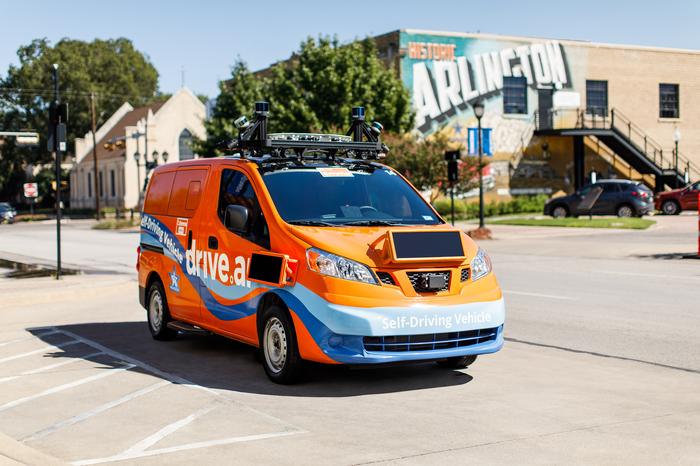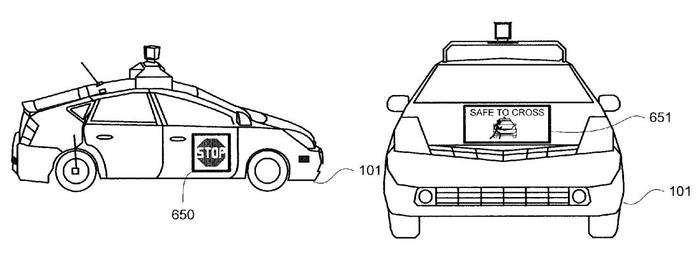From a young age we are taught to look both ways before crossing the road, and if a car gives way for us, to look the driver in the eye.
“Never assume a driver sees you. Make eye contact if possible,” says the guidance given by the Queensland government. “Be cautious and make sure you make eye contact with the driver,” says South Australia’s Towards Zero Together road safety campaign.
That sound advice won’t apply when driverless cars become ubiquitous on our roads, however. Those in the connected automated vehicle (CAV) may not be facing forward, or might be too engrossed in the onboard entertainment to be looking at their surroundings. The vehicle might not even have windows.
How then will pedestrians be confident they have been seen by the CAV’s sensors? How will other road users be aware of the vehicles intentions? Such questions are now being considered by the major players in self-driving vehicle technology, and they are coming up with a range of solutions.
Whether the message displays, light projections and big cartoon eyes actually work is yet to be seen.
“It’s second-nature to glance at the driver of the approaching vehicle before stepping into the road. Understanding how this translates in tomorrow’s more automated world is important,” says future mobility research manager at Jaguar Land Rover (JLR), Pete Bennett.
“Coming through”
Drive.ai, which is currently running two driverless ride-hailing services (with hands-off ‘chaperones’) in Texas, says it “thought carefully” about pedestrian interactions.
Its fleet of vehicles is bright orange with signage in large font – ‘Self-Driving Vehicle’ – plastered on all sides. On the front, back and both sides of the vehicles, there are also “exterior communication panels that effectively communicate and convey our vehicles’ intended actions with pedestrians” the company explains.

These display messages like ‘Waiting for you to cross’ are shown alongside symbols, say of a person crossing a zebra crossing.

Google – whose sister company Waymo is a leader in the field – in 2015 was granted a US patent for a similar solution. Electronic displays could show a stop sign or text, the patent details, or a speaker could call out alerts such as “coming through”.

Nissan too is exploring display messages: Its 2015 IDS Concept vehicle featuring an outward facing display that gives messages like “After you”.
A 2017 study by researchers at Duke University in North Carolina questions the usefulness of such displays, however. After fitting a large forward facing display to a Dodge van participants were told was self-driving, researchers found only 12 per cent of pedestrians used the displays (showing a symbol of a walking figure, and another with a line through it) to help them decide when to cross. Most relied on “legacy behaviors” such has speed of approach when deciding when to make the crossing, researchers said.
There are also safety concerns about a display saying ‘safe to cross’.
“When crossing a four-lane road, does ‘safe to cross’ mean a car isn’t approaching in the next lane? When multiple pedestrians are crossing from opposite sides of the street, to which of them is the car’s ‘safe to cross’ message directed?” asked Duke researcher Michael Clamann.
Clear intentions
Rather than instruct pedestrians, other players in the space are developing solutions that simply let other road users know they’ve been seen.
In August last year, JLR fitted Aurrigo-made driverless pods at its UK lab with ‘virtual eyes’.
“The pods seek out the pedestrian – appearing to ‘look’ directly at them – signalling to road users that it has identified them, and intends to take avoiding action,” explained JLR’s Bennett.

The ongoing work involves recording trust levels in pedestrians before and after the pod makes ‘eye contact’ to find out whether the method generates sufficient confidence that the pod would stop for them.
“We want to know if it is beneficial to provide humans with information about a vehicle’s intentions or whether simply letting a pedestrian know it has been recognised is enough to improve confidence,” Bennet said.
Nissan’s IDS Concept featured a similar, and perhaps more aesthetically pleasing, version of the ‘eyes’; an LED light strip the company calls the ‘Intention Indicator’ which shines white when pedestrians or cyclists are nearby “signalling that the car is aware of them”.
An alternative tack being taken by vehicle-makers is for their driverless cars to better indicate to pedestrians planned movements and speeds.
JLR and Mitsubushi have each unveiled solutions that project light onto the road, to inform pedestrians and other road users of the vehicle’s intended path.

In JLR’s case – revealed this week – the projections feature a series of white bars.

“The gaps shorten as the pod is preparing to brake before fully compressing at a stop. As the pod moves off and accelerates, the spacing between the lines extends. Upon approaching a turn, the bars fan out left or right to indicate the direction of travel,” JLR New Zealand general manager, Steve Kenchington explained.
Communication breakdown
The major CAV players are keen to get the communication with pedestrians right, and quickly. Trust in driverless vehicles is faltering. Although must studies look at people’s confidence to travel in a self-driving car, a 2018 study by the American Automobile Association – conducted in the wake of Uber’s self-driving vehicle fatality – found two thirds of Americans felt less safe sharing the road with self-driving vehicles while walking or cycling.
Another poll, by insurance company AIG in 2017, found about 41 per cent of those surveyed didn't want to share the road with driverless cars.
A 2016 poll by European driverless shuttle programme CityMobil2 found pedestrians most wanted to know whether they had been detected by CAVs.
“At the moment the most important thing is there is absolutely no information and communication between the vehicle and the people,” University of Leeds researcher Natasha Merat told The Guardian. “So pedestrians don’t know its intentions.”
Just as there is no universally adhered to signal for drivers to indicate they are giving way to a pedestrian – it might be a nod, a wave of the hand or a flash of headlights – there is not yet an agreed on signal for driverless vehicles either.
An opinion piece for the ABC by Australia’s chief scientist Alan Finkel, suggested it could be down to governments to regulate such signals.
“The purpose of regulation is ultimately to build trust in our ability to innovate safely,” he wrote in July.
With a million driverless cars predicted to be on Australia’s roads by 2035 – according to the NRMA – an effective solution will have to be found and agreed on soon.
“An essential part of the technology's successful integration into our society will be the development of intuitive methods of communication between road users; in the same way we have used hand signals and indicators to communicate with others for generations,” Kenchington said.

